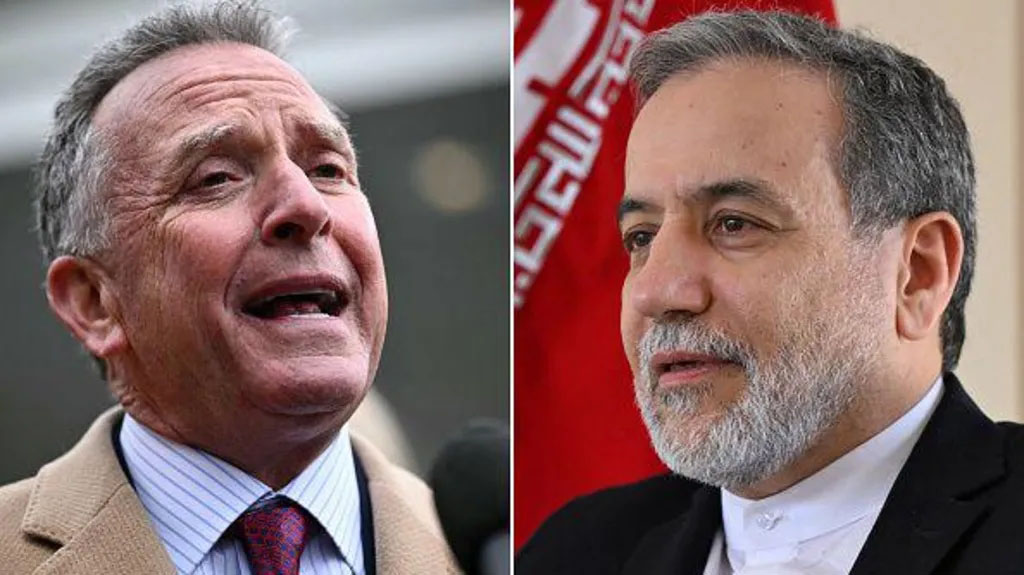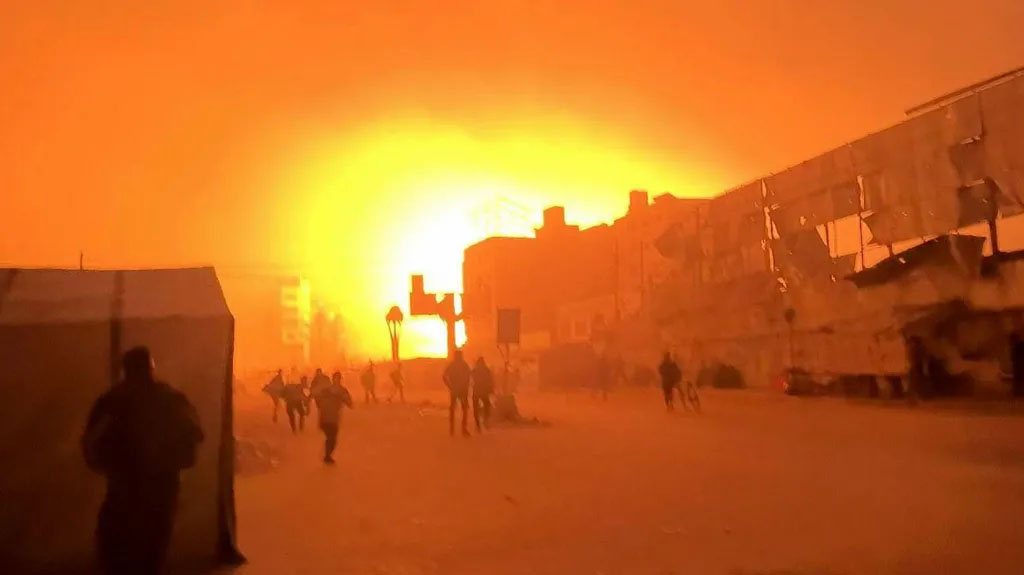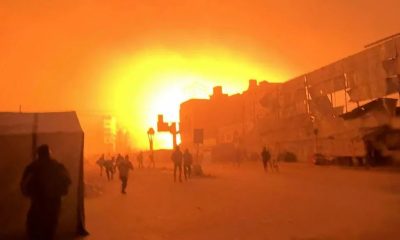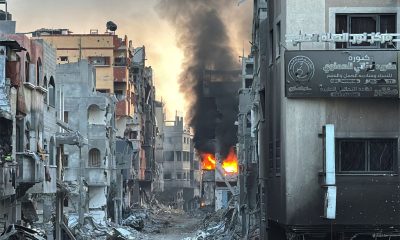International
Israel expands Gaza ground offensive

Israel expands Gaza ground offensive
The Israeli military said Sunday its ground offensive had expanded to every part of Gaza, and it ordered more evacuations in the crowded south while vowing that operations there against Hamas would carry “no less strength” than its shattering ones in the north.
Heavy bombardment followed evacuation orders, and Palestinians said they were running out of places to go in the sealed-off territory bordering Israel and Egypt. Many of Gaza’s 2.3 million people are crammed into the south after Israel ordered civilians to leave the north in the early days of the war, which was sparked by the Oct. 7 Hamas-led attack in Israel that killed about 1,200, mostly civilians.
The United Nations estimates that 1.8 million Palestinians in Gaza have been displaced. Nearly 958,000 of them are in 99 U.N. facilities in the south, said Juliette Toma, director of communications at the U.N. agency for Palestinian refugees.
After dark, gunfire and shelling were heard in the central town of Deir al-Balah as flares lit the sky. In Gaza’s second-largest city of Khan Younis, Israeli drones buzzed overhead. U.N. human rights chief Volker Türk urged an end to the war, saying civilian suffering was “too much to bear.”
The Health Ministry in Hamas-run Gaza said the number of people killed there since Oct. 7 has surpassed 15,500, with more than 41,000 wounded. The ministry does not differentiate between civilian and combatant deaths, but said 70% of the dead were women and children.
READ ALSO:
- Japa: US Embassy interviews over 150,000 Nigerians for visas in 2023
- Nigerian sentenced in the US over N307m fraud
- Tinubu under fire over 1,411 Nigerian delegates to COP28 Dubai
A Health Ministry spokesman asserted that hundreds had been killed or wounded since a weeklong cease-fire ended Friday. “The majority of victims are still under the rubble,” Ashraf al-Qidra said.
Fears of a wider conflict intensified. A U.S. warship and multiple commercial ships responded to distress signals from container ships in the Red Sea, the Pentagon said. Yemen’s Iran-backed Houthi rebels claimed attacks on two ships they described as being linked to Israel but did not acknowledge targeting a U.S. vessel.
Hopes for another temporary truce in Gaza were fading. The cease-fire facilitated the release of dozens of the roughly 240 Gaza-held Israeli and foreign hostages in exchange for Palestinians imprisoned by Israel. But Israel has called its negotiators home and Prime Minister Benjamin Netanyahu says the war will continue until “all its goals” are achieved. One is to remove Hamas from power in Gaza.
Senior Hamas official Osama Hamdan said resuming talks with Israel on further exchanges must be tied to a permanent cease-fire.
White House National Security Council spokesman John Kirby told “Face the Nation” on CBS News that the U.S. is “trying to work hour by hour to see if we can get this pause reinstated and get those hostages out.”
“While the pause has been lifted, and no hostage exchanges are going on, what is still going on, importantly, is humanitarian assistance getting in, including fuel, which is critical,” Kirby added.
Israel’s military widened evacuation orders in and around Khan Younis in the south, telling residents of at least five more areas to leave. Residents said the military dropped leaflets calling Khan Younis “a dangerous combat zone” and ordering them to move to the border city of Rafah or a coastal area in the southwest.
But Halima Abdel-Rahman, a widow and mother of four, said she won’t heed such orders anymore. She fled her home in October to an area outside Khan Younis, where she stays with relatives.
“The occupation tells you to go to this area, then they bomb it,” she said by phone. “The reality is that no place is safe in Gaza. They kill people in the north. They kill people in the south.”
READ ALSO:
- APC secures total victory in Ekiti council poll
- ‘Tinubu won’t tolerate killer herders’ – Sunday Igboho tells Miyetti Allah
- Israel expands Gaza ground offensive
- Japa: US Embassy interviews over 150,000 Nigerians for visas in 2023
The United States, Israel’s closest ally, has urged Israel to avoid significant new mass displacement and do more to protect civilians. U.S. Vice President Kamala Harris told Egypt’s president that “under no circumstances” would the U.S. permit the forced relocation of Palestinians from Gaza or the West Bank, an ongoing siege of Gaza or the redrawing of its borders.
On the ground in Gaza, there was fear and mourning. Outside a Gaza City hospital, a dust-covered boy named Saaed Khalid Shehta dropped to his knees beside the bloodied body of his little brother Mohammad, one of several bodies laid out after people said their street was hit by airstrikes. He kissed him.
“You bury me with him!” the boy cried. A health worker at Al-Ahli Baptist Hospital said more than 15 children were killed.
Israel’s military said its fighter jets and helicopters struck targets in Gaza including “tunnel shafts, command centers and weapons storage facilities.” It acknowledged “extensive aerial attacks in the Khan Younis area.”
The bodies of 31 people killed in bombardment of central Gaza were taken to the Al-Aqsa hospital in Deir al-Balah, said Omar al-Darawi, a hospital administrative employee. One woman wept, cradling a child’s body. Another carried the body of a baby. Later, hospital workers reported 11 more dead after another airstrike. Bloodied survivors included a child carried in on a mattress.
Outside a hospital morgue in Khan Younis, resident Samy al-Najeila carried the body of a child. He said his sons had been preparing to evacuate their home, “but the occupation didn’t give us any time. The three-floor building was destroyed completely, the whole block was totally destroyed.” He said six of the bodies were his relatives.
“Five people are still under the rubble,” he said. “God help us.”
In a video from the same crowded al-Nasser hospital, UNICEF spokesperson James Elder said: “I feel like I’m almost failing in my ability to convey the endless killing of children here.”
Israel says it does not target civilians and has taken measures to protect them, including its evacuation orders. In addition to leaflets, the military has used phone calls and radio and TV broadcasts to urge people to move from specific areas.
Israel says it targets Hamas operatives and blames civilian casualties on the militants, accusing them of operating in residential neighborhoods. It claims to have killed thousands of militants, without providing evidence. Israel says at least 78 of its soldiers have been killed.
READ ALSO:
- Nigerian sentenced in the US over N307m fraud
- Tinubu under fire over 1,411 Nigerian delegates to COP28 Dubai
- Bush burning responsible for fire incident at FRCN, Kaduna — Official
Kirby said that the U.S. is in discussion with Israel “about being careful, precise and deliberate in their targeting and trying to minimize civilian casualties to the maximum extent possible.”
“I think it’s also important for people to remember what they’re up against here. Hamas deliberately shelters themselves inside residential buildings, hospitals and schools,” Kirby said when asked by “Face the Nation” host Margaret Brennan if the White House has established “red lines” in the terms of U.S. military aid to Israel.
“It’s an added burden that Israel has as a modern military, we recognize that, but it’s also a very difficult burden and obstacle for them to overcome,” Kirby said.
The widening offensive likely will further complicate humanitarian aid to Gaza. Wael Abu Omar, a spokesman for the Palestinian Crossings Authority, said 100 aid trucks entered Sunday, but U.N. agencies have said 500 trucks per day on average entered before the war.
The renewed hostilities also heightened concerns for the 137 hostages the Israeli military believes are still being held by Hamas. During the recent truce, 105 hostages were freed, and Israel released 240 Palestinian prisoners. Most of those released by both sides were women and children.
Elsewhere in the region, Lebanon’s militant Hezbollah group said it struck Israeli positions near the tense Lebanon-Israel border. Eight soldiers and three civilians were wounded by Hezbollah fire in the area of Beit Hillel, army radio reported. The military said its artillery struck sources of fire from Lebanon and its fighter jets struck other Hezbollah targets.
Iraqi militants with the Iran-backed umbrella group the Islamic Resistance in Iraq said they struck the Kharab al-Jir U.S. military base in Syria with rockets. A U.S. military official, speaking on condition of anonymity in line with regulations, said rockets hit Rumalyn Landing Zone in Syria but there were no reports of casualties or damage.
Later Sunday, officials with Iranian-backed militias in Iraq said five militia members were killed in an airstrike blamed on the U.S. near Kirkuk. The officials spoke on condition of anonymity because they were not authorized to comment publicly. U.S. military officials could not immediately be reached for comment. for comment.
Israel expands Gaza ground offensive
cbsnews
International
US, Iran hold ‘constructive’ first round of nuclear talks

US, Iran hold ‘constructive’ first round of nuclear talks
Iran and the US have concluded a first round of talks in Oman over Tehran’s nuclear programme – the highest-level meeting between the two nations since 2018.
Both countries described the meeting as “constructive” and confirmed a second round of discussions will take place next week – with the US hailing the “direct communication” as being key to striking a possible deal.
President Donald Trump pulled the US out of a previous nuclear agreement between Iran and world powers in 2018, and has long said he would make a “better” deal.
The talks are seen as an important first step in establishing whether a deal can be done.
At two-and-a-half hours, the first meeting was brief, reportedly respectful – and set the stage for a second round.
That was probably as good as it could get when Iranian and US officials sat down in Muscat, the capital of Oman – whose top diplomat mediated the primarily indirect negotiations.
They were the most significant talks since Trump pulled the US out of the Iran nuclear deal of 2015 during his first term in office.
The verdict of Iran’s lead negotiator, Foreign Minister Abbas Araghchi, was positive.
“In my opinion, as the first meeting, it was a constructive meeting held in a very peaceful and respectful environment, because no inappropriate language was used,” he told Iranian state TV.
His diplomatic tone suggests the US team led by Trump’s envoy Steve Witkoff did not reiterate some of the president’s threats that Iran would face “great danger” if this dialogue did not succeed. He has repeatedly warned of possible military strikes.
READ ALSO:
- 2025 UTME: JAMB releases mock results
- Trump exempts smartphones, computers from new tariffs
- Gaza hospital hit by Israeli strike, Hamas-run health ministry says
This meeting ran with the delegations in separate rooms, relaying messages through Oman’s foreign minister, Badr bin Hamad al-Busaidi.
Witkoff, who is leading the US delegation, had previously only spoken of meeting face-to-face.
But Araghchi and Witkoff did speak for a few minutes in the presence of Busaidi – not the direct talks US officials said would happen but what could be a small but significant opening.
Iran, mindful of pressure from hardliners at home, underlined how limited their face-to-face exchange was, with no photographs taken.
In a statement following the talks, the White House said the discussions “were very positive and constructive”, noting that Witkoff had emphasised to Iran that he had instructions to resolve the adversaries’ “differences through dialogue and diplomacy, if that is possible”.
“These issues are very complicated, and special envoy Witkoff’s direct communication today was a step forward in achieving a mutually beneficial outcome,” the statement added.
Araghchi had said ahead of the discussions that his country wanted a “fair agreement”.
After the talks concluded, he said discussions next week may not happen in Oman, but would still be mediated by the Middle Eastern nation. The White House said they would take place next Saturday.
“Neither we, nor the other party, want fruitless negotiations, discussions for discussions’ sake, time wasting or talks that drag on forever,” Araghchi told Iranian state television.
The most important issue at stake is what kind of deal each side would be willing to accept.
Trump sent a letter to Iran’s supreme leader via the United Arab Emirates last month, saying he wanted a deal to prevent Iran from acquiring nuclear weapons and to avert possible military strikes by the US and Israel.
Iran hopes for a deal to limit, but not dismantle, its nuclear programme in exchange for sanctions relief.
An unnamed source in Oman told news agency Reuters that the talks would seek to de-escalate regional tensions and secure prisoner exchanges.
READ ALSO:
- Massilia Motors launches new Mitsubishi L200 with low fuel consumption, advanced engineering
- London mother sentenced to life in prison for drowning two sons
- LASRRA, LASDA to launch strategic documentation drive for Lagos diaspora database
Trump revealed the talks would take place during a visit by Benjamin Netanyahu to the White House on Monday. The Israeli prime minister said on Tuesday that both leaders had agreed that Iran “will not have nuclear weapons”.
Netanyahu has called for a “Libya-style deal”, referring to the north African nation completely dismantling its weapons programme in an agreement reached with Western powers in 2003. That would be completely unacceptable to Iran.
Iran insists its nuclear activities are entirely peaceful and that it will never seek to develop or acquire nuclear weapons.
Iranian officials have made it clear the negotiations will focus only on its nuclear programme, not its broader defence capability, such as its ballistic missile programme.
Ahead of the talks, Trump said on Friday that he wanted Iran “to be a wonderful, great, happy country – but they can’t have nuclear weapons”.
Trump has warned that the US would use military force if a deal was not reached, and Iran has repeatedly said it will not negotiate under pressure.
But this process is taking place under immense pressure.
Even as preparations were under way to arrange this first meeting, the US moved more warships and stealth bombers to the region and imposed more sanctions.
The US president told reporters in the Oval Office on Monday it would “be a very bad day for Iran” if the talks were unsuccessful.
Iran insists its nuclear activities are entirely peaceful and that it will never seek to develop or acquire nuclear weapons.
However, since Trump pulled out of the 2015 agreement – which expires later this year – Iran has increasingly breached restrictions imposed by the existing nuclear deal in retaliation for crippling US sanctions reinstated seven years ago, and has stockpiled enough highly-enriched uranium to make several bombs.
Under the terms of the 2015 deal, Iran agreed to only enrich uranium up to 3.67% purity for the next 15 years.
In February, the International Atomic Energy Agency (IAEA) nuclear watchdog reported that Tehran had stockpiled uranium enriched to 60% purity and could swiftly move to 90%, which would be weapons-grade.
The 2015 nuclear deal took nearly two years of intensive negotiations. At the start of this new effort to reach an agreement, Iran’s programme is far more developed and complex, and the wider region is far more volatile.
US, Iran hold ‘constructive’ first round of nuclear talks
BBC
International
Trump exempts smartphones, computers from new tariffs

Trump exempts smartphones, computers from new tariffs
US President Donald Trump’s administration has exempted smartphones, computers and some other electronic devices from “reciprocal” tariffs, including the 125% levies imposed on Chinese imports.
In a notice, US Customs and Border Patrol said that the goods would be excluded from Trump’s 10% global tariff on most countries and the much larger Chinese import tax.
It marks the first significant reprieve of any kind in Trump’s tariffs on China, with one trade analyst describing it as a “game-changer scenario”.
Late on Saturday, while travelling to Miami, Trump said he would give more details of the exemptions at the start of next week.
“We’ll be very specific,” he told reporters on Air Force One. “But we’re taking in a lot of money. As a country we’re taking in a lot of money.”
The move came after concerns from US tech companies that the price of gadgets could skyrocket, as many of them are made in China.
Exemptions – backdated to 5 April – also include other electronic devices and components, including semiconductors, solar cells and memory cards.
READ ALSO:
- Gaza hospital hit by Israeli strike, Hamas-run health ministry says
- Massilia Motors launches new Mitsubishi L200 with low fuel consumption, advanced engineering
- London mother sentenced to life in prison for drowning two sons
“This is the dream scenario for tech investors,” Dan Ives, who is the global head of technology research at Wedbush Securities, posted on X. “Smartphones, chips being excluded is a game-changer scenario when it comes to China tariffs.”
Big tech firms such as Apple, Nvidia, Microsoft and the broader tech industry can breathe a huge sigh of relief this weekend, he added.
The White House indicated the exemptions were made to ensure companies had more time to move production to the US.
“President Trump has made it clear America cannot rely on China to manufacture critical technologies such as semiconductors, chips, smartphones, and laptops,” White House Press Secretary Karoline Leavitt said in a statement.
“At the direction of the president, these companies are hustling to onshore their manufacturing in the United States as soon as possible.”
Trump, who is spending the weekend at his Florida home, told reporters on Friday he was comfortable with the high tariffs on China.
“And I think something positive is going to come out of that,” he said, touting his relationship with Chinese President Xi Jinping.
These electronic goods are still subject to the 20% tariff on China related to fentanyl, White House Deputy Chief of Staff on Policy Stephen Miller posted on X.
Some estimates suggested iPhone prices in the US could have as much as tripled if costs were passed on to consumers.
The US is a major market for iPhones, while Apple accounted for more than half of its smartphones sales last year, according to Counterpoint Research.
It says as much as 80% of Apple’s iPhones intended for US sale are made in China, with the remaining 20% made in India.
Like its fellow smartphone giant Samsung, Apple has been trying to diversify its supply chains to avoid an over-reliance on China in recent years.
India and Vietnam emerged as frontrunners for additional manufacturing hubs.
As the tariffs took effect, Apple reportedly looked to speed up and increase its production of India-produced devices in recent days.
Trump had planned for a host of steep tariffs on countries around the world to take effect this week.
But on Wednesday he announced he would implement a 90-day pause for countries hit by higher US tariffs – except China, whose tariffs he raised to 145%.
Trump said the tariff increase for China was because of the country’s readiness to retaliate with its own 84% levy on US goods.
In a dramatic change of policy, Trump said all countries that had not retaliated against US tariffs would receive the reprieve – and only face a blanket tariff of 10% – until July.
The White House then said the move was a negotiating tactic to extract more favourable trade terms from other countries.
Trump has said his import taxes will address unfairness in the global trading system, as well as bring jobs and factories back to the US.
Trump exempts smartphones, computers from new tariffs
BBC
International
Gaza hospital hit by Israeli strike, Hamas-run health ministry says

Gaza hospital hit by Israeli strike, Hamas-run health ministry says
An Israeli air strike has destroyed part of a hospital in Gaza City, the territory’s Hamas-run health ministry has said.
Witnesses said the strike destroyed the intensive care and surgery departments of Al-Ahli Baptist Hospital, the main medical facility in Gaza City.
Video posted online appeared to show huge flames and smoke rising from the hospital after missiles hit a two-storey building. People, including some patients still in hospital beds, were filmed rushing away from the site.
Israel said it was looking into reports of the strike. No casualties were reported, according to the civil emergency service.
The health ministry said the building was “completely destroyed”, leading to the “forced displacement of patients and hospital staff”.
A local journalist, who was working at the hospital, said the Israel Defense Forces (IDF) had phoned a doctor who was operating in the emergency department and asked them to evacuate the hospital immediately.
“All patients and displaced people must go out to a safe distance,” the officer reportedly said.
READ ALSO:
- Massilia Motors launches new Mitsubishi L200 with low fuel consumption, advanced engineering
- London mother sentenced to life in prison for drowning two sons
- LASRRA, LASDA to launch strategic documentation drive for Lagos diaspora database
“You have only 20 minutes to leave.”
Footage on social media showed staff and patients leaving the building while it was still dark outside.
Dozens of Palestinians, including women and children, were also seen fleeing from a courtyard inside the hospital where they had been seeking shelter.
Al-Ahli – a small medical facility before the war – is now the only hospital still functioning in Gaza City following the destruction of Al-Shifa medical complex and hospitals in the northern part of the Strip.
In its statement, the Hamas-run government media office condemned the attack.
Israel “is committing a horrific crime by targeting Al-Ahli Hospital, which houses hundreds of patients and medical staff”, it said.
In October 2023, an attack on the same hospital killed hundreds of people.
Palestinian officials blamed an Israeli strike for the blast. Israel said the blast was caused by a failed rocket launch by the Palestinian Islamic Jihad militant group, which denied responsibility.
The Israeli military launched a campaign to destroy Hamas in response to an unprecedented cross-border attack on 7 October 2023, in which about 1,200 Israelis were killed and 251 others were taken hostage.
More than 50,933 people have been killed in Gaza since then, according to the territory’s Hamas-run health ministry.
Of those, 1,563 have been killed since 18 March, when Israel restarted its offensive in the Gaza Strip, the ministry said.
Gaza hospital hit by Israeli strike, Hamas-run health ministry says
BBC
-

 metro1 day ago
metro1 day agoKidnapping: Our lives are hanging by a thread, residents of Igbogbo-Baiyeku communities in Lagos cry out
-

 International2 days ago
International2 days agoUS announces new visa requirements for Nigerian applicants
-

 International1 day ago
International1 day agoUS embassy announces new visa interview requirements for Nigerian applicants
-

 Sports1 day ago
Sports1 day agoBreaking: Former Super Eagles coach Christian Chukwu passes away at 74
-

 Sports2 days ago
Sports2 days agoCristiano Ronaldo ventures into movie industry, unveils new studio
-

 Politics2 days ago
Politics2 days agoAtiku leads Tambuwal, El-Rufai, others to Buhari as 2027 election draws near
-

 metro2 days ago
metro2 days agoIbadan Pastor ends 30-year-marriage over sex dispute with wife
-

 Education2 days ago
Education2 days agoSanwo-Olu gifts LASU best graduating student N10m













